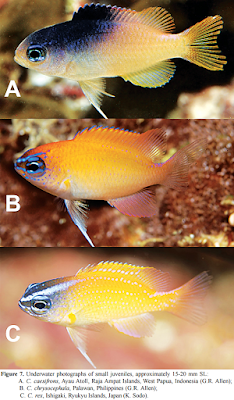Abstract
Chrysiptera caesifrons is described on the basis of 23 type specimens, 23.3–48.5 mm SL, from the Raja Ampat Islands (West Papua Province), Indonesia, and 184 additional non-types, 17.8–60.7 mm SL, from Papua New Guinea, Vanuatu, New Caledonia, and the Great Barrier Reef of Australia. Additional records based on photographic evidence and underwater observations include Halmahera and the Solomon Islands. The new species is closely allied to C. rex from the Ryukyu Islands, Taiwan, Palau, eastern Indonesia (eastern Kalimantan and Java eastward), Timor Leste, Raja Ampat Islands (off western extremity of New Guinea), and offshore reefs of Western Australia, as well as to C. chrysocephala from the South China Sea region and Sulawesi. Although the new species was previously confused with C. rex, it is clearly separable from both sibling species on the basis of colour pattern and from C. rex by a 6.4% difference (average pairwise distance) in the mitochondrial control region DNA sequence and from C. chrysocephala by a 4.3% difference (K2P minimum interspecific distance) in the barcode COI mtDNA sequence.
Key words: coral reef fishes, taxonomy, systematics, Indo-Pacific Ocean, barcode DNA sequence.
Chrysiptera caesifrons, n. sp.
Greyback Damsel
Distribution and habitat. The new species is primarily restricted to the southwestern Pacific Ocean (Fig. 3)
with confirmed records from Halmahera and West Papua, Indonesia, northeastern Papua New Guinea (including
New Britain, Admiralty Islands, and Milne Bay Province), Solomon Islands, Vanuatu, New Caledonia, and
Australia. Australian localities include the entire extent of the Great Barrier Reef. The habitat consists of rocky
substrates, frequently close to shore, often in gullies just below the surge zone at depths of about 1–6 m. It
generally occurs solitarily or in small, loose groups.
Etymology. The species is is named caesifrons (Latin: “bluish-grey forehead”, caesius for blue-grey and
frons for forehead or brow) with reference to its distinguishing colour pattern. It is a third declension compound
adjective in the feminine nominative singular.
G.R. Allen, M.V. Erdmann and M. Dailami. 2015. Chrysiptera caesifrons, A New Species of Damselfish (Pomacentridae) from the south-western Pacific Ocean. Journal of the Ocean Science Foundation. 15: 16-32.

